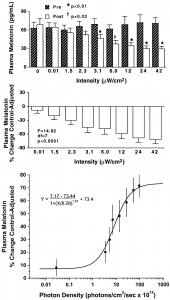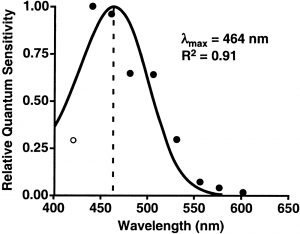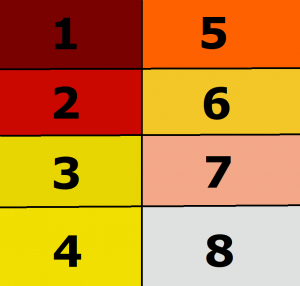Introduction
This lesson will provide an accurate examination of glasses that filter light. How light affects melatonin & the boundaries that you should consider to enjoy a good circadian health.
This calculator will calculate the impact of your current dark period setup on your melatonin levels. The purpose of this calculator is to be newbie-friendly with simple outputs.
Version 4 of the calculator is out!
USE THE CALCULATOR TO FIGURE OUT WHICH FILTERING GLASSES YOU SHOULD BUY
How to Use the Program
- After opening the spreadsheet, first, copy the file and save it on your own Drive. See cell B1.
- Next, there are multiple different settings for you to play around with. You should go for the most extreme settings in your environment. This means that distances should be minimal, etc.
In the current version of the calculator, there’s an option to add up to 5 different light sources.
For example:
If you’re sitting in a room with lights and a computer screen, those would need 2 separate rows to accurately determine their effects on you.
Inputs
Temperature (B3:B8)
- Input the color temperature of the environment you are in. This program currently supports increments of 500 (500, 1000, 1500, etc.)
- When using a screen filtering software on your computer, input that value.
- There are also temperatures of purchased light bulbs on their package.
Distance (C3:C8)
- Type the distance to the light source.
Power (D3:D8)
- Type the power output of the light source.
- If you do not know what it is, you can find several approximations online.
Light type (E3:E8)
- Select which type of light you want to see the effects of.
- Different types of light convert the power to different illuminating rates.
Light distribution (F3:F8)
- Change in which directions the emitting light concentrates.
- For light bulbs, you can enter 360.
- For computer screens, you can use 120, etc.
Exposure duration (G3)
- The longer you expose yourself to light, the more your melatonin is going to suffer.
- You should use the full duration of your awake dark period. However, if you want to see how much briefly removing your glasses will affect your melatonin levels, you can alter this number.
Melatonin suppression boundary (G3)
- Input what melatonin suppression percentage you want to receive a warning for.
- The precise, recommended percentage is still unknown; however, based on this study1, this level reduces SWS.
Best filter match (H3)
- In column K, which color best matches the filtering glasses that you are using?
- Type the corresponding number on column J into H4.
- If you have no glasses, leave H4 empty or as “0”.
- When the filtering specifications of your glasses aren’t available in the list, you can enter the “Behind the scenes” tab. Then, manually input the specifications.
- Stronger filters will correspond to lower numbers. For example “1” will filter more light than “8”. Because of this, go for the glasses that filter the least amount of light but still keep you above the melatonin suppression boundary in your specific lighting situation. Those will induce the least tiredness and facilitates your adaptation the most.
- Additionally, go get a pair of strong glasses for unexpected situations where you will be exposed to bright lights.
Outputs
After you have inserted all information, you will see what the expected melatonin suppression percent will be in cell B8.
- If this number is higher than your melatonin suppression boundary, a warning message will be visible on cell B11.
- You will also see the expected melatonin phase shift in cell C8, where a smaller number is better.
Unless you want to manually alter something behind the scenes, there is really no reason to access that tab. If you do not want to bother with it or see the math used, stay in the “Inputs” tab.
Read the sections below if you are interested in the math behind the calculations. If you just want to get the essentials and avoid all the complications, continue to the next lesson after using the calculator.
Filtering glasses
First, why do different filtering glasses produce different results? This is because:
- Different wavelengths of light affect the melatonin production at different rates.
- Additionally, different filtering glasses will filter out certain ranges of light more than others.
- Determining the exact filtering properties of glasses can be very tricky without fancy equipment.
To make things simple, a picture with different colors also allows you to visually compare your laser filtering glasses with the references; this is applicable to no-brand glasses. The accuracy of this comparison will not be all too high; this is especially because glasses with similar colors might actually filter out certain ranges of light differently than others. However, it is the easiest solution available for you; you should still take the results with a grain of salt.
Research
As one study points out, different wavelengths of light suppress melatonin at different intensities2.
- Based on this information, it is possible to calculate the sum of the melatonin suppression from all light emitted from different temperatures and estimate the total suppression.
- Notably, in this study, the baseline for a 2-hour exposure, even in total darkness, results in a reduction of melatonin levels by 7%.
This is because of a natural reduction of melatonin, not what we are interested in. - The purpose of this calculator is only to provide the effects of artificial melatonin reduction. Because of that, the light wavelength suppression reference will be 0% at 0 lux, regardless of the exposure time.

The quantum sensitivity of light is also in consideration; this is the relative effect that different wavelengths of light has on melatonin levels.
For example:
Light at 464 nm has the highest quantum sensitivity at 1.00. At 550 nm, the quantum sensitivity is approximately 0.048.
The exposure to light at 464 nm is going to be more detrimental than at 550 nm.

Background
In this section you will learn about the intricacies of how we perform the calculations of the dark period calculator. You can skip this part if you do not want to know the mathematics behind the calculations.
Calculations
Because there was no equation for the relative quantum sensitivity in the research paper, we recreate it using pixel counting and Excel’s trendline feature:
![]()
- The total suppression was calculable by breaking the total lux emitted by a light source into all individual wavelengths.
- Then, multiply that with the suppression each wavelength produces.
- Afterwards, we add the values together to show how much suppression occurs at certain durations of exposure from certain distances.
We calculated the circadian phase shift with a 3-parameter logistic formula3:
![]()
Where:
- y=phase shift in hours
- a=0.240
- b=120
- c=-3.00
- x=lux.
Other Assumptions on Light Filtering
However, because this study only compared the phase shift after a 6.5-hour duration, we divide whole right side by 6.5. Then, we multiply it by the exposure duration in the spreadsheet.
- Because there were no tests on different wavelengths of light, only the total lux is accounted for.
- We assume a uniform phase shift regardless of the specific light wavelengths.
For light emitters, it is presumably total black body emitters. Planck’s law then calculates the proportions of specific intervals of light from certain Kelvin temperatures of the light source as a proportion of all visible light.
After that, we apply certain light filters to these numbers to reduce them by a certain percentage. See the picture below.
We assume homogenous, constant melatonin suppression for the different wavelengths.

(https://glarminy.com/blue-light-blocking-glasses/, accessed 12 Mar 2020).
At this point in time, there are two studies that describe the relation of SWS reduction to light intensity1,4. However, because both studies only compared single light-intensity situations, it is not possible to draw conclusions about a relationship between the suppression and light intensity.
Regardless, in the future, the community is going to test this out to figure out more specific correlations.
Conclusion
Hopefully, you should have a good tool to examine your surroundings’ impacts on your dark period by taking this lesson. I encourage you to save the calculator elsewhere so that you can always return to it in the future! Once you know how to filter light properly, you will soon enjoy great sleep quality!
Overall, special thanks to Evg-zhabotinsky and Boostmaster for helping with the calculations!
Main author: Crimson
Page last updated: 12 March 2021
Reference
- Cho, J.R., Joo, E.Y., Koo, D.L. and Hong, S.B. Let there be no light: the effect of bedside light on sleep quality and background electroencephalographic rhythms. Sleep medicine, 2013;14(12);1422-1425. doi:10.1016/j.sleep.2013.09.007. [PubMed]
- Brainard, G.C., Hanifin, J.P., Greeson, J.M., Byrne, B., Glickman, G., Gerner, E. and Rollag, M.D. Action spectrum for melatonin regulation in humans: evidence for a novel circadian photoreceptor. Journal of Neuroscience, 2001;21(16);6405-6412. doi:10.1523/JNEUROSCI.21-16-06405.2001. [PubMed]
- Zeitzer, J.M., Dijk, D.J., Kronauer, R.E., Brown, E.N. and Czeisler, C.A. Sensitivity of the human circadian pacemaker to nocturnal light: melatonin phase resetting and suppression. The Journal of physiology, 2000;526(3);695-702. doi:10.1111/j.1469-7793.2000.00695.x. [PubMed]
- Munch, M., Kobialka, S., Steiner, R., Oelhafen, P., Wirz-Justice, A. and Cajochen, C. Wavelength-dependent effects of evening light exposure on sleep architecture and sleep EEG power density in men. American Journal of Physiology-Regulatory, Integrative and Comparative Physiology, 2006;290(5);R1421-R1428. doi:10.1152/ajpregu.00478.2005. [PubMed]

